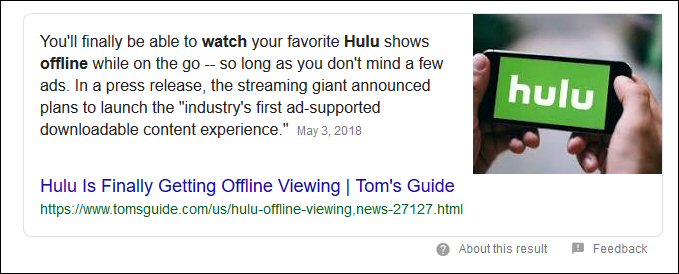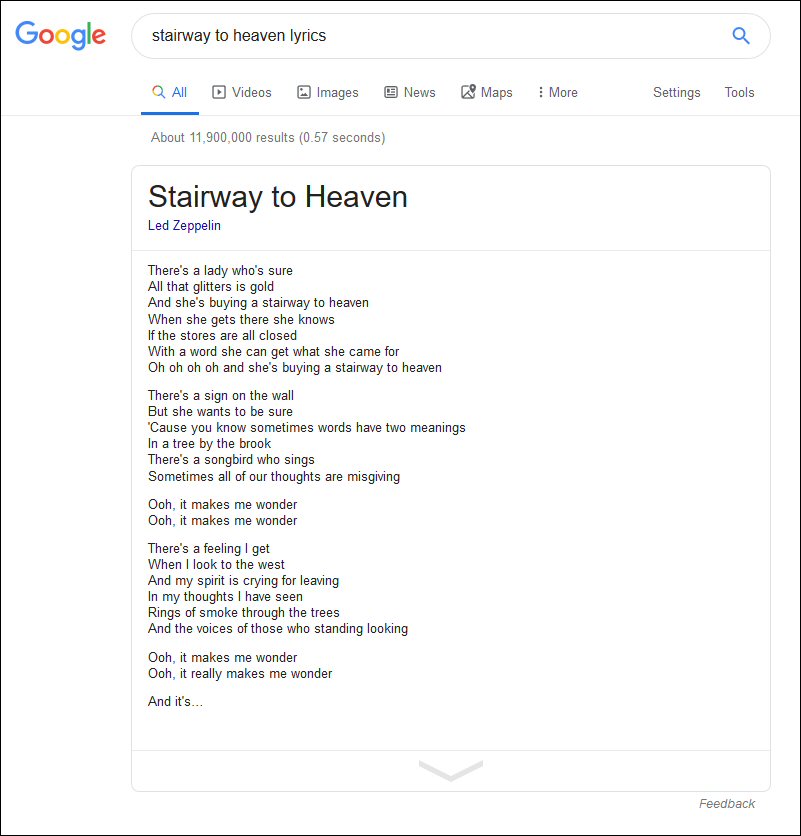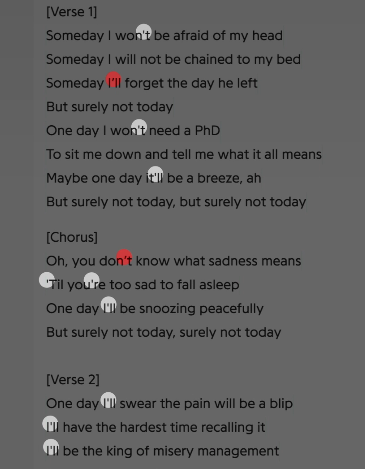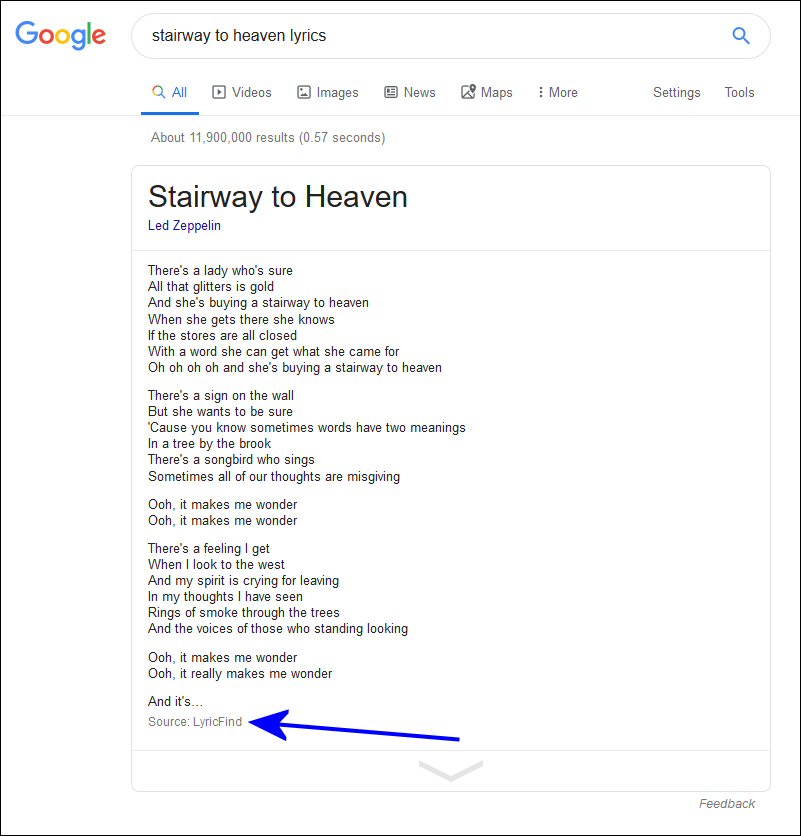Google: Facing the Music
The following is a quick study of the fascinating dynamics behind search page results. Most people don’t think too much about the complex nature of how Google arrives at its results, but that’s exactly what we do here at Five Blocks.
A Wall Street Journal story last month accused Google of sourcing content without giving credit to the source. The article said Google had been scraping music lyrics from genius.com, a popular lyrics site.
Some quick background: When you search for the lyrics of a song, Google often shows the lyrics in what’s called a “rich snippet”.
What are Rich Snippets? you may ask.
Rich snippets are boxes that contain content clipped directly from a third-party web page. Google uses these rich snippets because it is the fastest way to get searchers the answer to their query.
Here is an example:
This is all fine as long as Google credits the source – and ideally provides a link to click.
However, in the case of song lyrics, Google seems to have provided the name of the artist, but not the website the lyrics came from – below is an image from before the WSJ story was published:
As you can imagine, song lyrics appear on lots of sites. So how could Genius.com be so sure that Google was scraping their site?
They ran a test. They embedded patterns of apostrophes in the formatting of song lyrics. If this pattern was replicated in the rich snippet in search results, it would prove that genius.com was the original source. They used two different types of apostrophes throughout the lyrics, as below (as seen in the WSJ.com article referenced above):
Genius checked the rich snippet, and found the apostrophe pattern replicated, proving the content came from their site.
But now the plot thickens — a development we became aware of after recently sharing this story with our partners.
The lyrics site LyricFind offered a rebuttal of the WSJ story, citing their licensing agreement with Google, and claiming that the content came from their site.
In fact, in the days following the publication of the WSJ story, Google began showing LyricFind as the source, and including a link.
But what about Genius.com’s test? Here’s what LyricFind says:
“Some time ago…Genius notified LyricFind that they believed they were seeing Genius lyrics in LyricFind’s database. As a courtesy to Genius, our content team was instructed not to consult Genius as a source. Recently, Genius raised the issue again and provided a few examples. All of those examples were also available on many other lyric sites and services, raising the possibility that our team unknowingly sourced Genius lyrics from another location. [Italics ours. – YG]
As a result, LyricFind offered to remove any lyrics Genius felt had originated from them, even though we did not source them from Genius’ site. Genius declined to respond to that offer. Despite that, our team is currently investigating the content in our database and removing any lyrics that seem to have originated from Genius.”
In any event, it seems that Google, having implemented the change of crediting the source, has admitted that lyric sites, and not only artists, have certain rights — even if those are different than those held by the artist or publisher.
This episode is a reminder of how Google, with its complex automated systems that collect, process, categorize, and display information, needs to be closely monitored and managed.
In the same way that the system seems to have sourced content without proper attribution, that same mechanism often presents incorrect and damaging content about brands and individuals.
With so many stakeholders using Google to help them form opinions on people, companies, and issues, watching every detail related to Google’s top results is critical for your brand.
Another reminder that Intelligent Digital Reputation Management isn’t just “nice to have” — but an essential business strategy.
How Deep is Google’s Love?: Where the In-Depth Articles have Gone (and What it Means for You)
Recently, Google appears to have made a significant change to its search results page that eliminated several in-depth articles for many clients. We’ve taken a deeper dive into this development to see what it could mean for brands and high-profile individuals, and the PR professionals who work with them.
As you know, when searching for a brand or an individual, the Google search results page presents a variety of relevant content pieces and types of media to satisfy the query. Often this means a company’s own webpage will appear at the top, followed by third-party content such as Wikipedia and news sources. There may also be social media results (if an individual or brand actively maintains these platforms), along with image results or video content.
Several years ago, Google introduced a section within top search results they called “in-depth articles”. These results looked very similar to other search results, but came from longform media outlets like Variety, Rolling Stone, or The New York Times Magazine. Often, they were a seminal article about the brand in question – articles that may have been placed by their PR teams.
Including these articles on the top results page seems to have been Google’s way of ensuring that a greater variety (and deeper) content would appear in this prime spot. Their inclusion, and the actual articles that appeared within that section, were governed by a different set of algorithms than most search results.
Recently, this section disappeared from all search pages for brands and executives. This happened without any announcement or acknowledgment on the part of Google. It is important to note that in-depth articles for many brands and individuals contained negative content. At the same time, it was the place where particularly engaging longform journalism made its way onto the prime real estate of Google page 1 for a brand.
The ramifications of Google’s elimination of this section are yet to be seen, and their motivation can only be assumed to be “less intervention” following high profile criticism of potential bias in their algorithms.
A whole host of interesting questions arise from Google’s move: What is the corporate (and civic) responsibility of those who hold the world’s data in their hands? Are there cases for intervention? Who decides what those are?
It is interesting to note that alongside this mysterious disappearance, a recent Five Blocks study of CEO search results found there are far fewer news sites (sites such as CNN, CNBC, and others) on the first couple of pages of searches for a CEO compared to a year ago. In addition, those pages feature many more profile sites, where one would find more dry facts (often created by the brand), and less news.
This marked difference in the presence of news within the organic results over the course of the past year, alongside the recent removal of the in-depth article section, means that page 1 of search for brands and individuals will contain far more“owned” content – i.e.: information they control.
For some brands this would appear to be a positive turn of events, but for many this trend means they will not automatically have great media pieces (which they often earned by being genuinely great) appear prominently in searches. It means they will need to work harder to deliberately ensure that the best third-party media does in fact place highly within their profile. Savvy communications teams will find ways to enhance their brands’ online presence within these brave new parameters.
— Sam Michelson, with Sara K. Eisen
Five Blocks to Present at 2018 PRWeek “PRDecoded” Conference in Chicago – Thursday, October 18
 Curious to learn more about digital reputation management? Five Blocks will be in Chicago this week at the 2018 PR Week Conference. The conference promises to be a master class for communications pros in the ever-evolving digital world. Come hear from the best in the business and be sure to catch our CEO, Sam Michelson, speaking on Thursday, October 18 at 10:45 when he’ll share keys for cracking a digital reputation crisis. Don’t miss this informative and actionable conversation.
Curious to learn more about digital reputation management? Five Blocks will be in Chicago this week at the 2018 PR Week Conference. The conference promises to be a master class for communications pros in the ever-evolving digital world. Come hear from the best in the business and be sure to catch our CEO, Sam Michelson, speaking on Thursday, October 18 at 10:45 when he’ll share keys for cracking a digital reputation crisis. Don’t miss this informative and actionable conversation.
Our team will be at the conference all day and looks forward to seeing old friends and meeting new colleagues interested in discussing digital reputation management.




